Issue #121: Potato Galette
What's in a Name? The Mandoline I Can't Cook Without, Potatoes Are Yum
Things really seem to be picking up in New York this fall. Restaurants are packed, massive food events are back, it’s like 2019 all over again. My dance card is full. (Let’s just ignore for the time being, as everyone seems to be doing, that COVID-19 is also on the rise.) It’s been years now that I’ve cooked three, sometimes four meals a day. Now I find that if I have to be out of the house two or three meals in a row, I start to feel a little discombobulated. I miss my food. I do think there is something both to the act of preparing food and to knowing exactly what you are putting in your body, because you made it, that makes eating at home nourishing in a different way from eating out. I’ll hope to find better balance soon. In the meantime, gotta go… —Mitchell
When it comes to cooking, sometimes the simplest things are the best. Sure, a professional chef can do all sorts of stuff to make seemingly easy dishes more complicated. With sophisticated tools and techniques, some may even turn out more delicious. But just as often, all the effort is just a way to “add value” in order to justify the elevated price of eating out. I’m all about restaurants that serve food I’d never make myself. And I don’t mind paying what it costs to cook complicated food, buy good ingredients, and pay staff a living wage. But the beauty of cooking well at home is that you don’t have to complicate things to make something delicious.
Take this potato galette.
This dish of thinly sliced potatoes baked with onions and cheese is something I turn to when I want to make a “fancy” side dish, but I don’t want to fuss too much. All it requires is some potato, some type of onion or other allium, some cheese, and some fat. I almost always have these ingredients on hand. You can add herbs, if you wish. Use olive oil or butter, as you prefer. It’s a crowd pleaser that may even be better leftover. But I’ll get to that.
About the name. You might call it a gâteau, maybe even a gratin. But I like the word galette, which in English has come to mean a flat, free-form pie (see Issue 22), but which, according to several French dictionaries I consulted, can also simply mean colloquially anything plate et ronde, that is, “flat and round.” Apparently, a vinyl record is sometimes referred to in slang as une galette.
I tend to make this potato galette flat and round. But sometimes I make it tall and square. I guess that takes it more into gâteau territory.
Regardless, it is simple. But it isn’t quick. I get mad about the IRC (Industrial Recipe Complex) confounding simplicity with speed when it comes to cooking. Take last week’s recipe for beans, for example (see beans). I know that people think beans are really complicated because they have to soak overnight. But that soaking doesn’t require you to do anything besides remember to put some beans in a bowl with some water before you go to bed. That is NOT complicated. Sheesh.
(For a strong follow up to my own beans issue in support of the Beans is How Menu Challenge NYC, check out the current issue of Nancy Harmon Jenkin’s On the Kitchen Porch newsletter.)
Still, I recognize that for many people, the most difficult thing about cooking is timing. And in that sense, I understand why people who have trouble with timing may find something that requires some foresight and advance planning beyond their capabilities. I’d encourage you to push through.
I say all this because this potato galette needs to bake for a while, at least 90 minutes, until the potatoes are soft and the whole thing has cohered into a dense, delicious mass. Often the problem with potato dishes, scalloped or otherwise, is people underbake them. Nobody wants an al dente potato, unless you are making potato salad, for which I customarily overcook them, anyway.
Like much home-cooked goodness, this galette is the sort of dish you shouldn’t even need a recipe for (says the person who sends you weekly recipes for delicious home-cooked things). It’s also the sort of recipe that is even better leftover. Once chilled, I slice the galette and fry the slices in some olive oil in a nonstick pan until crisp to serve as a base for poached eggs or another different type of side dish. Use your imagination.
A Note about the Baking Dish
To bake this galette, I like to use a baking dish with a removable bottom, such as a springform pan. This allows me to lift out the galette to serve and cut nice pieces. But the fat tends to leak out. So, I wrap the bottom of the pan in a piece of aluminum foil that comes up at least an inch or so, and then set it on a rimmed baking sheet to protect my oven from drips. Then I line the pan with parchment. You can also just bake this in a regular, one-piece baking dish and cut it as you would a snacking cake. However, as with a cake, this technique makes neat removal of the first few pieces a bit of challenge. To help, line the pan with parchment with some overhang on two of the four sides so you can lift out the galette in one piece and set it on a cutting board before slicing.
I’m not sure what size baking dish to tell you to use. A larger dish produces a flatter result, more galette, I guess. A smaller one produces a higher result, more gâteau. It’s good both ways. The one you see depicted in the photographs in this issue was made in a 6-inch springform pan.
And Another Note about Potato Slicing
For the best texture of the finished galette, it is important to slice the potatoes thinly. I use my indispensable, hand-held mandoline with a ceramic blade from Kyocera, which is like an extension of my hand. I use it almost every day. You can use a different mandoline or slicer or a sharp knife. Whichever method you choose, thin slices are key.
RECIPE: Mitchell’s Potato Galette
About 1 pound potatoes, such as German butterballs, Yukon Golds, purple potatoes, or a combination, peeled and thinly sliced (see note above)
Extra-virgin olive oil or butter, at room temperature
½ red or white onion, 1 large shallot, or an equivalent amount of other allium, such as leek, scallion, or garlic chive, very thinly sliced
Salt and freshly ground black pepper
A couple of sprigs of fresh herbs, such as thyme or rosemary, leaves only (optional)
4 ounces or so aged alpine cheese, such as Gruyère, Comté, Asiago, or cheddar, or similar, very thinly sliced or grated
Preheat the oven to 350°F. If using a springform pan, wrap the outside bottom of the pan with a sheet of aluminum, as explained above, and line the inside bottom with parchment. If using a pan without a removable bottom, extend the parchment up two opposite sides to allow for easy removal. Grease the pan and parchment with a generous amount of olive oil or softened butter.
Spread a layer of about 1/4 of the potato slices on the bottom to cover the pan. Scatter about 1/3 of the sliced onion, season with a pinch of salt and some freshly ground pepper, a pinch of chopped herbs, if using, and scatter about 1/4 of the cheese. Drizzle with a little olive oil or dot with butter. Repeat these layers—potatoes, onions, seasoning, herbs, if using, cheese, and oil or butter—until you have layered the last of the potatoes. Sprinkle with salt and pepper and arrange the last of the cheese (no onion or herbs on top layer). Feel free to add more cheese on top, if you’d like. Drizzle with more olive oil or dot with butter.
Place the pan on a baking sheet and set in the preheated oven for about 1 hour and 30 minutes. The galette should have compacted, condensed and browned on top. To test doneness, insert the tip of a paring knife. If it slides in easily, it should be done. If the knife meets resistance, put it back some more baking, maybe 7 to 10 minutes at a time. Much better to err on the side of overbaked. Remove from the oven and cool for 10 minutes to settle. Remove the foil and sides of the springform, if using. Lift the galette out onto a serving plate. Slice as you would a cake to serve.
Wrap and chill and leftovers so you can slice them thinly and fry in oil until crisp for future goodness.



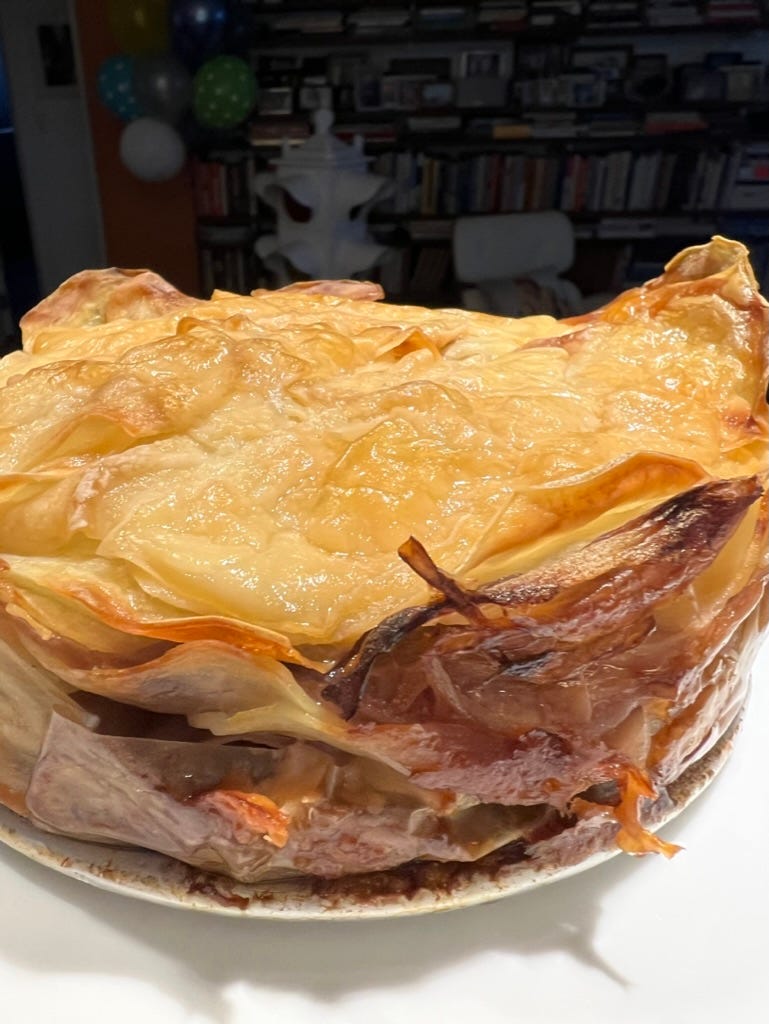
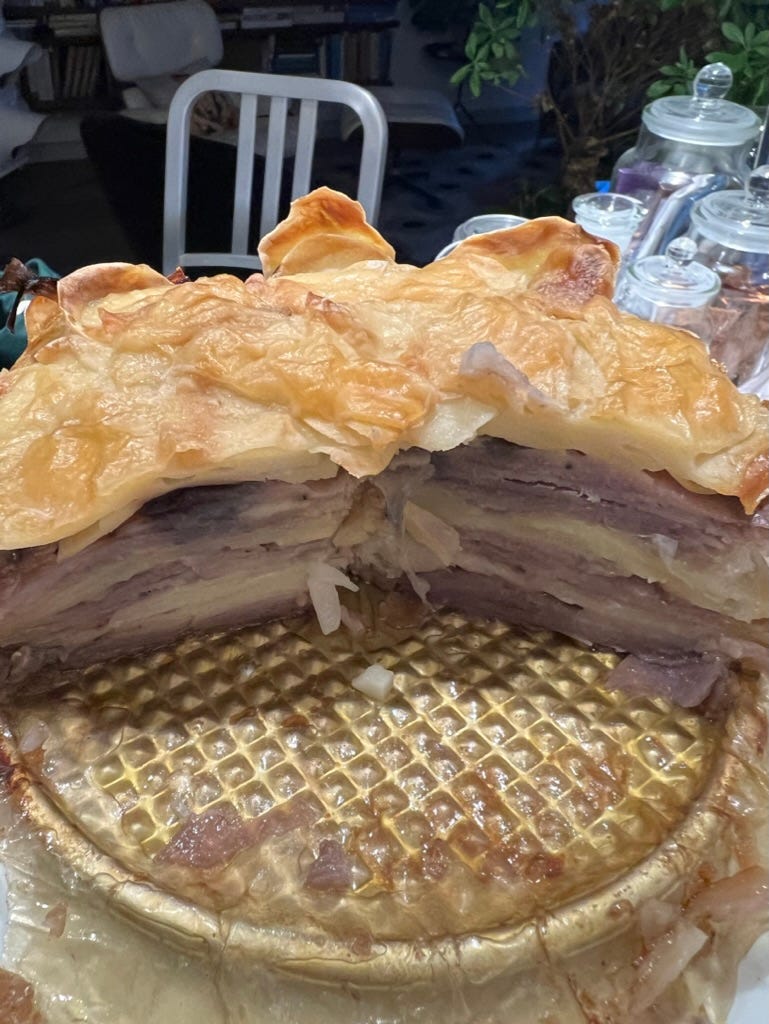

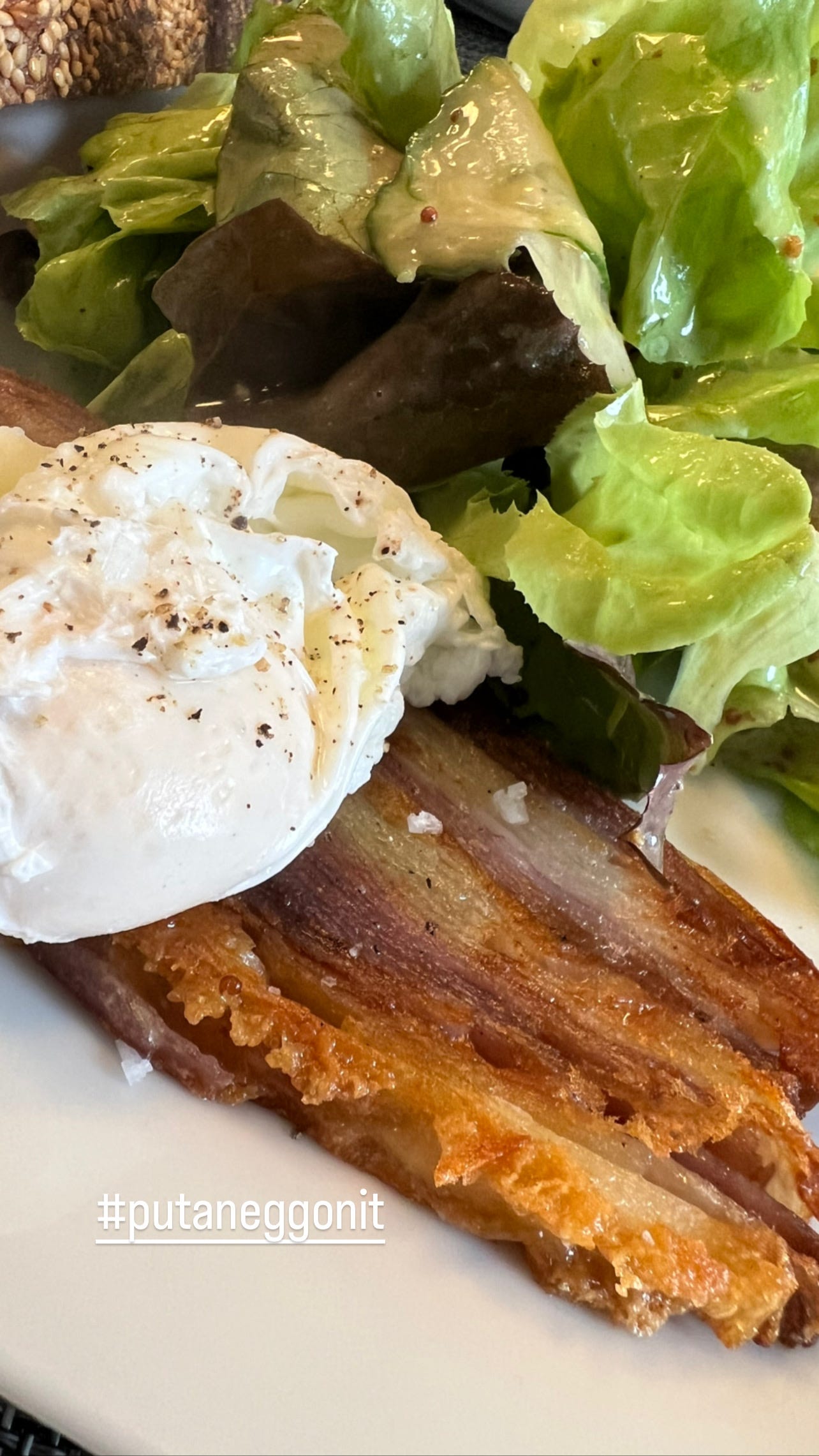
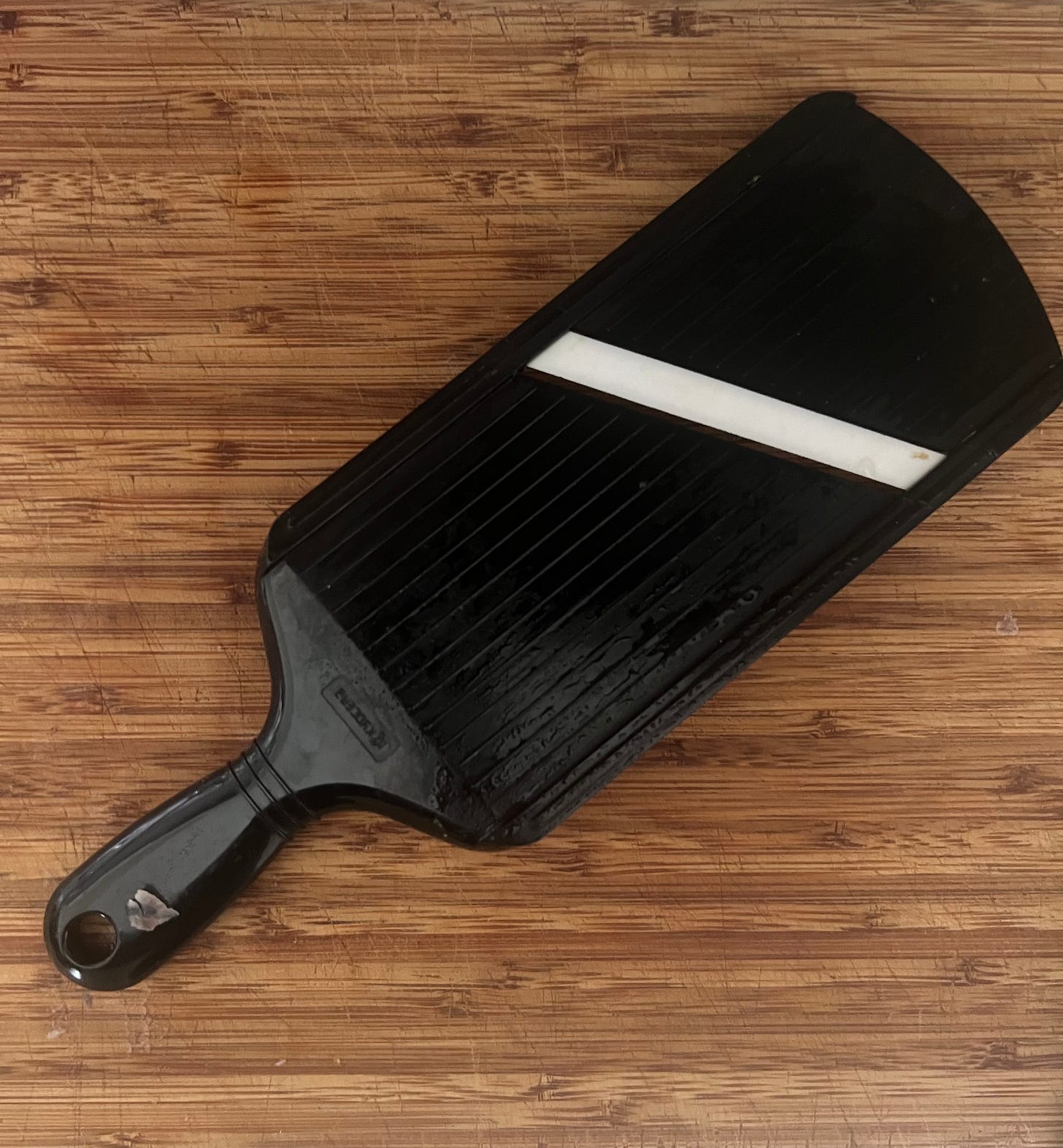
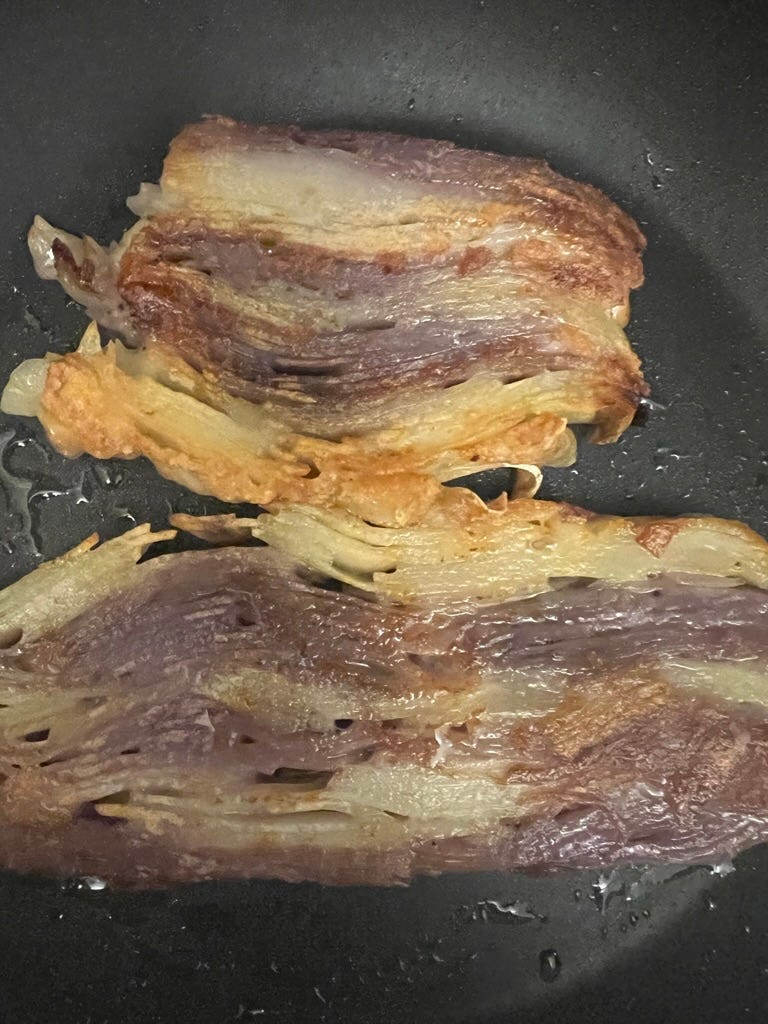
Utterly delicious. I look forward to making this for our annual thanksgiving feast instead of the more traditional gratin which it resembles only slightly. I am sufficiently attached to my peasant heritage to believe that just about anything tastes better if it begins with potatoes.